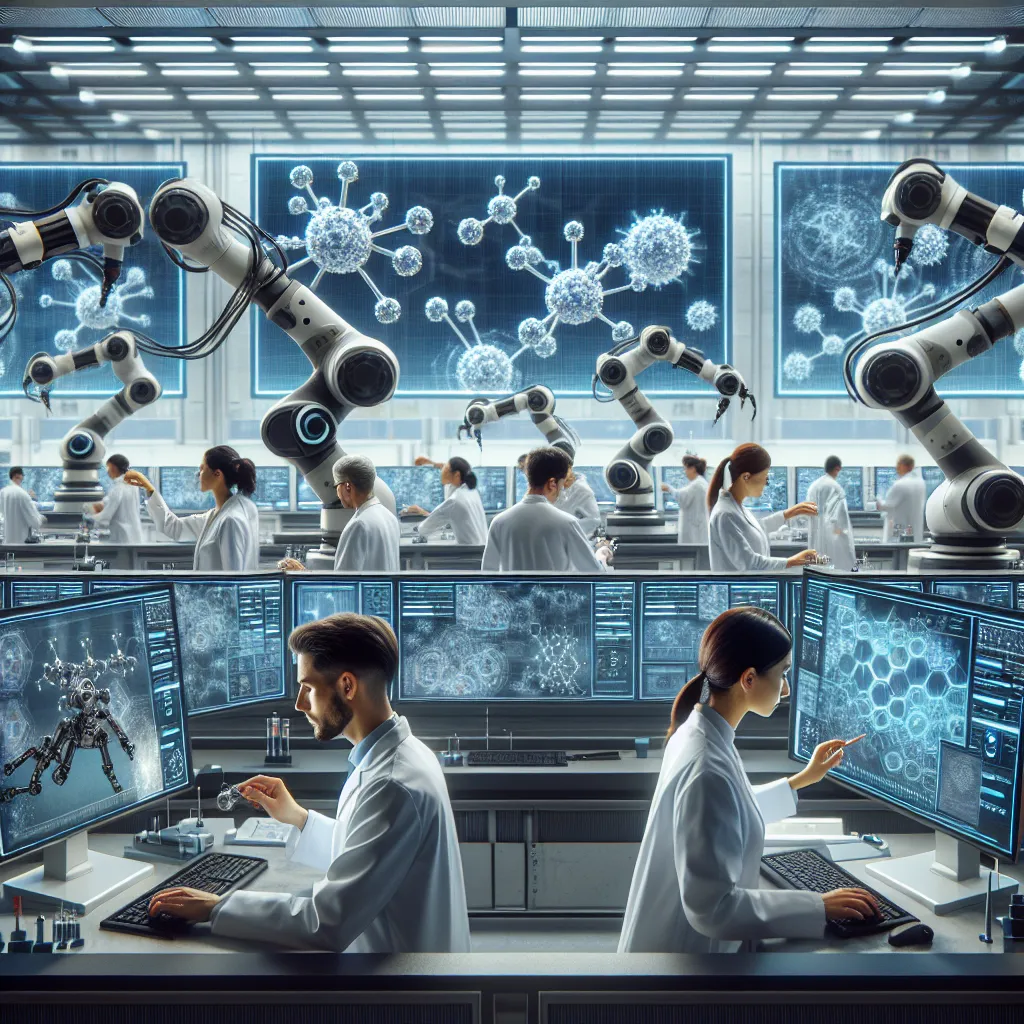The IELTS Reading section is a challenging component of the test, requiring candidates to demonstrate their ability to comprehend complex texts and answer questions accurately within a limited time frame. Today, we’ll focus on a topic that has been gaining traction in recent years and may likely appear in future IELTS exams: AI’s role in pharmaceutical development.
This subject combines elements of technology, healthcare, and scientific innovation, making it an ideal candidate for IELTS Reading passages. Based on current trends and the increasing importance of AI in various industries, we can predict that this topic will continue to be relevant in upcoming IELTS exams.
Let’s dive into a practice reading passage and questions to help you prepare for this potential topic.
 AI in pharmaceutical research
AI in pharmaceutical research
Reading Passage
AI’s Transformative Impact on Drug Discovery and Development
Artificial Intelligence (AI) is revolutionizing the pharmaceutical industry, offering unprecedented opportunities to accelerate drug discovery and development processes. This technological advancement is reshaping how researchers approach the creation of new medications, potentially saving years of time and billions of dollars in development costs.
One of the most significant contributions of AI in pharmaceutical research is its ability to analyze vast amounts of data at speeds impossible for human researchers. Machine learning algorithms can sift through millions of compounds, identifying potential drug candidates with a higher likelihood of success. This capability dramatically reduces the time spent in the initial stages of drug discovery, allowing scientists to focus their efforts on the most promising leads.
Moreover, AI is proving invaluable in predicting how drugs will interact with biological systems. Through complex simulations, AI models can forecast a compound’s behavior in the human body, its potential side effects, and its efficacy against specific diseases. This predictive power enables researchers to make more informed decisions about which drug candidates to pursue, potentially increasing the success rate of clinical trials.
The application of AI extends beyond the laboratory and into clinical trials themselves. AI algorithms can help identify suitable patients for trials, optimize trial designs, and even predict potential outcomes. This not only speeds up the trial process but also enhances its efficiency and accuracy.
However, the integration of AI in pharmaceutical development is not without challenges. Ensuring the quality and reliability of data used to train AI models is crucial. There are also ethical considerations regarding data privacy and the potential biases that could be introduced into AI systems.
Despite these challenges, the potential benefits of AI in drug development are too significant to ignore. As AI technologies continue to evolve, we can expect to see more targeted therapies, personalized treatments, and a general acceleration in the pace of pharmaceutical innovation.
The future of drug discovery and development is likely to be a synergistic relationship between human expertise and artificial intelligence. This collaboration promises to bring life-saving medications to patients faster and more efficiently than ever before, marking a new era in pharmaceutical research and development.
Questions
True/False/Not Given
For questions 1-5, read the following statements and decide if they are True, False, or Not Given based on the information in the passage.
- AI can analyze data faster than human researchers.
- Machine learning algorithms can identify potential drug candidates.
- AI is used to manufacture new drugs.
- AI can predict how drugs will interact with biological systems.
- The use of AI in pharmaceutical development is without any challenges.
Multiple Choice
Choose the correct letter, A, B, C, or D.
-
According to the passage, one of the main benefits of using AI in drug discovery is:
A) Reducing the cost of manufacturing drugs
B) Eliminating the need for human researchers
C) Accelerating the initial stages of drug discovery
D) Guaranteeing the success of all drug candidates -
The passage suggests that AI’s role in clinical trials includes:
A) Replacing human participants
B) Conducting the trials autonomously
C) Optimizing trial designs
D) Approving new medications
Matching Headings
Match the following headings to the correct paragraphs in the passage. Write the correct number (i-vii) next to questions 8-10.
i. Challenges in AI integration
ii. AI’s role in data analysis
iii. The future of pharmaceutical research
iv. AI’s predictive capabilities in drug interactions
v. The speed of AI in drug discovery
vi. Ethical considerations in AI use
vii. AI’s impact on clinical trials
- Paragraph 2: _____
- Paragraph 4: _____
- Paragraph 5: _____
Answer Key
-
True
-
True
-
Not Given
-
True
-
False
-
C
-
C
-
ii
-
vii
-
i
Explanations
-
The passage states that AI can analyze “vast amounts of data at speeds impossible for human researchers.”
-
The text mentions that “Machine learning algorithms can sift through millions of compounds, identifying potential drug candidates.”
-
The passage does not mention AI being used in drug manufacturing.
-
The passage explicitly states that “AI models can forecast a compound’s behavior in the human body.”
-
The passage mentions challenges, stating “the integration of AI in pharmaceutical development is not without challenges.”
-
C is correct. The passage states that AI “dramatically reduces the time spent in the initial stages of drug discovery.”
-
C is correct. The passage mentions that “AI algorithms can help identify suitable patients for trials, optimize trial designs.”
-
Paragraph 2 discusses AI’s ability to analyze vast amounts of data, matching heading ii.
-
Paragraph 4 talks about AI’s application in clinical trials, matching heading vii.
-
Paragraph 5 discusses the challenges of integrating AI in pharmaceutical development, matching heading i.
Common Mistakes
-
Overlooking specific details: Many test-takers might miss the nuances in statements like question 3, where the information is simply not provided in the text.
-
Confusing similar concepts: For example, in question 6, students might confuse accelerating drug discovery with reducing manufacturing costs.
-
Misinterpreting partial information: In question 7, test-takers might choose A or B if they don’t carefully read the entire paragraph about AI’s role in clinical trials.
-
Rushing through the matching headings: This task requires careful reading of both the paragraphs and the headings to find the best match.
Vocabulary
- Revolutionizing (verb) /ˌrev.əˈluː.ʃə.naɪ.zɪŋ/ – to completely change something so that it is much better
- Unprecedented (adjective) /ʌnˈpres.ɪ.den.tɪd/ – never having happened or existed in the past
- Sift (verb) /sɪft/ – to examine something carefully
- Efficacy (noun) /ˈef.ɪ.kə.si/ – the ability to produce a desired or intended result
- Synergistic (adjective) /ˌsɪn.əˈdʒɪs.tɪk/ – working together in a way that produces an effect greater than the sum of their individual effects
Grammar Focus
Complex sentences with multiple clauses are common in academic texts. For example:
“Through complex simulations, AI models can forecast a compound’s behavior in the human body, its potential side effects, and its efficacy against specific diseases.”
This sentence structure allows for the presentation of multiple related ideas within a single statement, enhancing the flow and coherence of the text.
Tips for IELTS Reading Success
-
Time management: Allocate your time wisely between reading the passage and answering questions.
-
Skim and scan: Quickly skim the passage for main ideas, then scan for specific details when answering questions.
-
Read questions carefully: Ensure you understand what each question is asking before searching for the answer.
-
Use contextual clues: If you encounter unfamiliar words, try to deduce their meaning from the context.
-
Practice regularly: Familiarize yourself with different question types and passage structures through consistent practice.
-
Don’t leave blanks: Even if you’re unsure, always provide an answer as there’s no penalty for incorrect answers.
-
Check your answers: If time allows, review your answers to catch any obvious mistakes.
By following these strategies and practicing with passages on current topics like AI in pharmaceutical development, you’ll be well-prepared for the IELTS Reading section. Remember, understanding the content is just as important as mastering the test-taking techniques. Good luck with your IELTS preparation!


